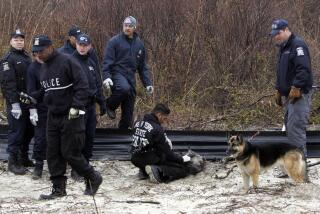Serial killer Israel Keyes: Police sensed he’d killed before
Israel Keyes seemed a little too familiar with killing.
After arresting the 34-year-old Anchorage, Alaska, construction contractor in Texas in March, investigators confronted him with evidence they believed implicated him in the kidnapping and slaying of an 18-year-old Anchorage barista in February.
Investigators say there was video of him leading Samantha Koenig away, and they have text records from her stolen phone, and had monitored withdrawals of ransom made with her debit card in areas where he was known to have traveled.
PHOTOS: Victims of confessed killer Israel Keyes
With his attorney present in late March, Keyes confessed, officials said.
The confession to Koenig’s killing represented the first crack in a dam of silence that would slowly crumble over months of effort.
“I was convinced he had committed other murders and other crimes,” Kevin Feldis, chief of the criminal division for the U.S. Attorney’s office in Alaska, told the Los Angeles Times. “It was his descriptions of what he had done. We could tell that this was not coming from a person who had done this for the first time.”
On Monday, a day after Keyes’ apparent jailhouse suicide in Anchorage, officials laid out the nationwide investigation that quietly unfolded against Keyes, who is now thought to be responsible for killing as many as eight people in four states. Details of the suicide were not revealed.
After Keyes’ arrest, he was brought to Alaska, where he told investigators he had killed Koenig and left her body in Mantuska Lake in north Anchorage. Investigators soon found her body.
Keyes faced a possible death penalty, but continued to talk to the investigators trying to put him away. When they confronted him with their suspicion that he’d killed before, Feldis said, Keyes confessed to killing a Essex, Vt., couple missing since summer 2011.
Bill Currier, 49, and Lorraine Currier, 55, had no known enemies, Vermont officials said at a Monday news conference. “By all accounts they were friendly, peaceful, good people who encountered a force of pure evil acting at random,” said Tristram Coffin, U.S. Attorney for Vermont.
Their disappearance had confounded state officials, who had long suspected foul play but had few leads. At first, Keyes’ confession prompted skepticism, investigators said -- his claims were vague, and he might have pulled details of their disappearance from the news in Vermont, which he said he’d been following.
But on the condition that his name not be publicly connected to the crime, officials said, Keyes offered enough detail of the couple’s slaying that investigators now consider the case closed.
On June 2, 2011, Keyes flew from Alaska to Chicago, bringing a gun and a silencer, with the “specific purpose” of kidnapping and killing someone, Chittenden County State’s Attorney T.J. Donovan said.
Keyes told investigators he hadn’t chosen a victim but had specific criteria for whom he wanted to attack. He wanted somebody whose house had an attached garage, who didn’t have children. It had to be somebody without a dog, and somebody whose house had a simple layout, so he could easily find the bedroom.
Keyes rented a car and drove east. Five days later, on June 7, he arrived at a hotel in Essex, and on the next night, he left looking for somebody to kill, officials said.
The Curriers’ home had an attached garage. They didn’t have kids. They didn’t have dogs, or a security system. Keyes cut the telephone wire to the home, then broke into their garage, took a crowbar off the wall, smashed the glass separating the garage from their home and “engaged in a blitz attack on the Curriers,” Donovan said.
Within five or six seconds, he was in their bedroom, where he tied the couple up with zip ties. Keyes said he then forced them to the garage and into their car, and drove them to a nearby barn.
Keyes took Bill Currier in through the back of the barn and tied him to a stool in the basement, officials said. But when he came outside again, he found that Lorraine Currier had broken free and was running away.
Keyes tackled Lorraine Currier and took her into the barn, officials said. But Bill Currier had started to break free in the interim. “Where’s my wife?” Bill Currier repeatedly yelled, Keyes told investigators. He continued to yell for his wife even after Keyes hit him with a shovel, at which point Keyes shot and killed him.
Becoming visibly distressed as he recalled these details at the Monday news conference, Donovan said that Keyes confessed to sexually assaulting Lorraine Currier and choking her to death. He placed both bodies in plastic bags and hid them under debris in the barn basement before moving them to a landfill.
Officials never found their remains, and suspect they never will.
Keyes said he drove off in their car with the intent of robbing a bank in Vermont, but abandoned the vehicle after deciding it seemed unreliable. He fled to Maine but returned, passing by the couple’s house, where he noticed police crime scene tape. He continued through town.
The couple’s disappearance remained unresolved until Alaskan authorities phoned to tell Vermont officials in April that Keyes had confessed; officials then persuaded the Curriers’ family to keep quiet about the extent of the investigation, for fear that Keyes would stop talking. Keyes had hinted at killing four people in Washington and one person in New York before killing the Curriers.
At some point, Keyes threw his gun and a gun he’d stolen from the Curriers into a reservoir in Parishville, N.Y., which FBI divers recovered this summer after Keyes told officials where to find them.
After a family member slipped and told local media that Keyes was implicated in the Curriers’ death, Keyes stopped talking to investigators for a while.
Keyes was enigmatic. He had attempted a dramatic escape from a pretrial hearing in Anchorage in May, in which he leaped over a railing into the spectators’ gallery before he was Tasered into submission. Even after the escape attempt, after he’d been identified publicly as a suspect in the Vermont killings, and facing the possibility of a death penalty charge, Keyes cooperated, investigators said.
“Cooperating is maybe not the completely accurate term for it,” Feldis said. “We’d been talking to him.”
Feldis said he did not believe Keyes was telling officials about his killings out of the hopes of avoiding execution. Nor did he seem to care about the victims’ families’ feelings.
“He was not interested in that,” Feldis said. “He was not moved by the idea of giving closure to the families of his victims.” Feldis said Keyes seemed somewhat more interested in having control over his own story rather than having his crimes discovered by the police.
A Vermont police official who interviewed Keyes by phone called his description of the Currier killings calm, unemotional and without remorse.
“He provided some motivation, but I don’t think it’s really able to be pigeonholed exactly why he did this,” said Coffin, the U.S. Attorney for Vermont. “He described to investigators that these were volitional acts,” Coffin said, and that “it was something he controlled, and that he liked to do it.”
With Keyes’ suicide, the remaining killings he professed to have committed remain shrouded in uncertainty.
“He described disposing bodies of up to four victims in Washington state,” Feldis said. “Where those victims were from originally, we don’t know for sure, and we don’t know their identities. He didn’t tell us. The body he described disposing in New York state, we don’t know where that person was from, and we don’t know their identity at this point.”
Koenig’s family in Alaska expressed regret at Keyes’ death and the loss of a trial and a chance for justice; the Curriers’ family expressed thanks for getting a little closure. Bill and Lorraine Currier had been given a funeral without any bodies.
But there will be little closure for law enforcement, which is continuing a massive investigation, with diminished hopes for resolution. As recently as Thursday, Keyes had given out information, although details were again vague, Feldis said. Keyes had shown no signs that he was going to commit suicide last week, Feldis said, although he had been on suicide watch a few months ago.
“It’s unfortunate that there may be a lot of speculation about what he may or may not have done,” Feldis said, “and that’s another tragic result of his own actions.”
[For the record, 6:11 p.m. Dec. 3: An earlier version of this post said Keyes had shown no sign that he would commit suicide. Feldis said Keyes had been on suicide watch a few months ago but no longer was.]
ALSO:
Salon reopens after fatal rampage
Jovan Belcher talked to Chiefs officials, walked away, shot himself
Colorado wildfire, fueled by voracious winds, burns thousands of acres
More to Read
Sign up for Essential California
The most important California stories and recommendations in your inbox every morning.
You may occasionally receive promotional content from the Los Angeles Times.











